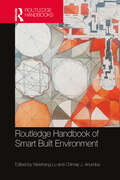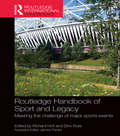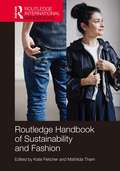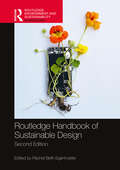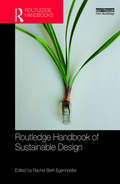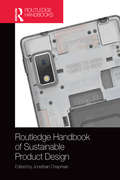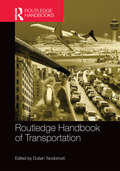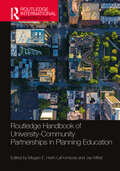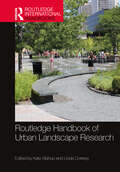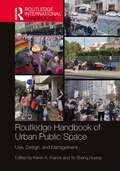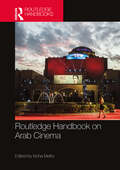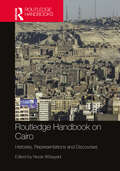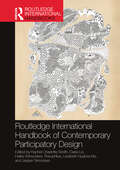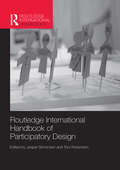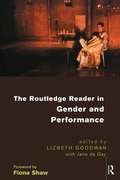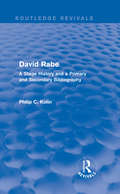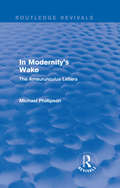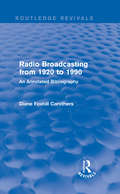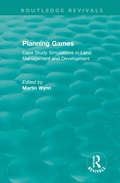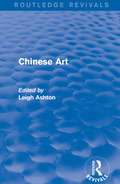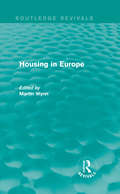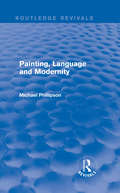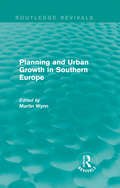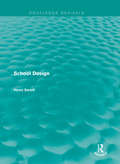- Table View
- List View
Routledge Handbook of Smart Built Environment
by Chimay J. Anumba Weisheng LuThe primary aim of this edited volume is to document the current theories, best practices, and technological advancements in the move towards a Smart Built Environment (SBE). The needs to accelerate towards the SBE are numerous and include: Increasing complexities and the need for interconnectivity within the built environment (e.g. mega infrastructure projects) Data-driven decision-making resulting in higher demand from clients (e.g. smart design, construction, operation, and end of life [EOL]) High requirements from stakeholders (e.g. system efficiency, environmental performance, green procurement) Fast paced technological advancement and integration Natural disaster resilience of the built environment (e.g. prediction, smart control of building component) Sustainability issues around the built environment In this book, the interrelationships among the various lifecycle stages: design, construction, operation, and EOL; the collective benefit of synergy at building level, multi-infrastructure level, and city-level, as well as the ultimate goals in relation to the deployment of smart technologies in the industry are addressed. Part I covers smart design and construction, Part II smart living, and operation, and Part III broadens the scope to the whole smart city. Chapters examine: How smart technologies can improve the effectiveness, productivity, and efficiency of the built environment An overview of theories and practices that are enabled by innovations and technologies for developing the SBE The basis for new research agenda, new concepts, and frameworks for future development This handbook documents the current theories, practices, and technologies and develops a holistic approach for research and practice by adopting a multidimensional outlook for the SBE. It is an essential reference work for all built environment stakeholders, from academia through to the professions.
Routledge Handbook of Sport and Legacy: Meeting the Challenge of Major Sports Events (Routledge International Handbooks)
by Dino Ruta Richard HoltWhat remains of a great sporting spectacle after the last race is run or the final match is played? How can the vast expense of mounting such events be justified? What if there is nothing left behind or what if the legacy is negative, a costly infrastructure which is unused or a debt-ridden host city? The Routledge Handbook of Sport and Legacy addresses perhaps the most important issue in the hosting of major contemporary sporting events: the problem of ‘legacy’. It offers a rigorous, innovative and comparative insight into this contested concept from interdisciplinary and practical perspectives. Major events must now have a conscious, credible and defined policy for legacy to meet public expectations. The book provides a comprehensive survey of the various kinds of legacy that can be delivered, as well as a close examination of the potential benefits and practical challenges involved in each. From ‘hard’ legacies, such as stadia and infrastructure, to ‘soft’ legacies including skill development, attitude change and capacity building, the book offers both a historical case study and an innovative strategic management approach, and establishes the limits of what can realistically be achieved in terms of economic, social, cultural, physical and sporting development. The Routledge Handbook of Sport and Legacy includes contributions from world leading scholars and practitioners and features detailed case studies of major sports events from around the world, including the FIFA World Cup and ten Olympics Games from London in 1908 to London 2012. It is invaluable reading for students and researchers working in sport studies, events management, human geography, economics or planning, and an essential reference for any professional engaged in delivering legacy through sport.
Routledge Handbook of Street Culture (Routledge International Handbooks)
by Jeffrey Ian RossDiscussions of street culture exist in a variety of academic disciplines, yet a handbook that brings together the diversity of scholarship on this subject has yet to be produced. The Routledge Handbook of Street Culture integrates and reviews current scholarship regarding the history, types, and contexts of the concept of street culture. It is comprehensive and international in its treatment of the subject of street culture. Street culture includes many subtypes, situations, locations, and participants, and these are explored in the various chapters included in this book. Street culture varies based on numerous factors including capitalism, market societies, policing, ethnicity, and race but also advances in technology. The book is divided into four major sections: Actors and street culture, Activities connected to street culture, The centrality of crime to street culture, and Representations of street culture. Contributors are well respected and recognized international scholars in their fields. They draw upon contemporary scholarship produced in the social sciences, arts, and humanities in order to communicate their understanding of street culture. The book provides a comprehensive and accessible approach to the subject of street culture through the lens of an inter- and/or multidisciplinary perspective. It is also intersectional in its approach and consideration of the subject and phenomenon of street culture.
Routledge Handbook of Sustainability and Fashion (Routledge International Handbooks)
by Kate Fletcher Mathilda ThamThe clothing industry employs 25 million people globally contributing to many livelihoods and the prosperity of communities, to women’s independence, and the establishment of significant infrastructures in poorer countries. Yet the fashion industry is also a significant contributor to the degradation of natural systems, with the associated environmental footprint of clothing high in comparison with other products. Routledge Handbook of Sustainability and Fashion recognizes the complexity of aligning fashion with sustainability. It explores fashion and sustainability at the levels of products, processes, and paradigms and takes a truly multi-disciplinary approach to critically question and suggest creative responses to issues of:• Fashion in a post-growth society • Fashion, diversity and equity • Fashion, fluidity and balance across natural, social and economic systems This handbook is a unique resource for a wide range of scholars and students in the social sciences, arts and humanities interested in sustainability and fashion.
Routledge Handbook of Sustainable Design (Routledge Environment and Sustainability Handbooks)
by Rachel Beth EgenhoeferThe Routledge Handbook of Sustainable Design considers the design, not only of artifacts, but of structures, systems, and interactions in the context of sustaining our shared planet. This revised edition introduces new and updated chapters, as well as a new section on pedagogy for sustainable design. With authors from around the world, design is positioned in context with recent crises such as global pandemics, racial reckoning, political unrest, and natural disasters. Just as design is an interdisciplinary field, the climate crisis is deeply tangled in racial justice, gender justice, global health, economics, trade, and more. Divided into six sections, it presents a holistic approach to understanding the many facets of sustainable design: Part 1: Systems and Design Part 2: Complexities of Sustainable Design Part 3: Community Engaged Design for Local and Global Diversity Part 4: Design for Sustainable Behaviors Part 5: Design Futures Part 6: Pedagogy in Design for Sustainability Arguing that design needs to restore, regenerate, and rejuvenate our planet and people, this handbook will be invaluable to researchers, students, and practitioners across all subdisciplines of design, architecture, business, energy management, visual arts, and environmental studies, among others.
Routledge Handbook of Sustainable Design (Routledge International Handbooks)
by Rachel Beth EgenhoeferThe Routledge Handbook of Sustainable Design considers the design, not only of artifacts, but of structures, systems, and interactions that bear our decisions and identities in the context of sustaining our shared planet. In addressing issues of design for global impact, behavior change, systems and strategy, ethics and values, this handbook presents a unique and powerful design perspective. Just as there are multiple definitions of design, so there are several definitions of sustainability, making it difficult to find unity. The term can sometimes be seen as a goal to achieve, or a characteristic to check off on a list of criteria. In actuality, we will never finish being sustainable. We must instead always strive to design, work, and live sustainably. The voices throughout this handbook present many different characteristics, layers, approaches, and perspectives in this journey of sustaining. This handbook divides into five sections, which together present a holistic approach to understanding the many facets of sustainable design: Part 1: Systems and Design Part 2: Global Impact Part 3: Values, Ethics, and Identity Part 4: Design for Behavior Change Part 5: Moving Forward This handbook will be invaluable to those wishing to broaden their understanding of sustainable design and students and practitioners of Environmental Studies, Architecture, Product Design and the Visual Arts.
Routledge Handbook of Sustainable Product Design
by Jonathan ChapmanAs a cultivated form of invention, product design is a deeply human phenomenon that enables us to shape, modify and alter the world around us – for better or worse. The recent emergence of the sustainability imperative in product design compels us to recalibrate the parameters of good design in an unsustainable age. Written by designers, for designers,?the Routledge Handbook of Sustainable Product Design presents the first systematic overview of the burgeoning field of sustainable product design. Brimming with intelligent viewpoints, critical propositions, practical examples and rich theoretical analyses, this book provides an essential point of reference for scholars and practitioners at the?intersection of product design and sustainability. The book takes readers to the depth of our engagements with the designed world to advance the social and ecological purpose of product design as a critical twenty-first-century practice. Comprising 35 chapters across 6 thematic parts, the book’s contributors include the most significant international thinkers in this dynamic and evolving field.
Routledge Handbook of Transportation
by Dušan TeodorovićThe Routledge Handbook of Transportation offers a current and comprehensive survey of transportation planning and engineering research. It provides a step-by-step introduction to research related to traffic engineering and control, transportation planning, and performance measurement and evaluation of transportation alternatives. The Handbook of Transportation demonstrates models and methods for predicting travel and freight demand, planning future transportation networks, and developing traffic control systems. Readers will learn how to use various engineering concepts and approaches to make future transportation safer, more efficient, and more sustainable. Edited by Dušan Teodorović and featuring 29 chapters from more than 50 leading global experts, with more than 200 illustrations, the Routledge Handbook of Transportation is designed as an invaluable resource for professionals and students in transportation planning and engineering.
Routledge Handbook of University-Community Partnerships in Planning Education (Routledge International Handbooks)
by Heim LaFrombois, Megan E. Jay MittalThis handbook explores two guiding questions – how can university-community partnerships in planning education work, and how can they be transformative? University-community partnerships – often referred to as service-learning or community-engaged teaching and learning – are traditionally based on a collaborative relationship between an academic partner and a community-based partner, in which students from the academic partner work within the community on a project. Transformational approaches to university-community partnerships are approaches that develop and sustain mutually beneficial collaborations where knowledge is co-created and new ways of knowing and doing are discovered. This edited volume examines a variety of university-community partnerships in planning education, from a number of different perspectives, with a focus on transformative models. The authors explore broader theoretical issues, including topics relating to pedagogy, planning theory, and curriculum; along with more practical topics relating to best practices, logistics, institutional support, outcome measures, and the various forms these partnerships can take – all through an array of case studies. The authors, which include academics, professional practitioners, academic practitioners, and students, bring an incredible depth and breadth of knowledge and experience from across the globe – Australia, Canada, Chile, Europe (including Germany, Spain, Slovakia, and Sweden), India, Jamaica, South Korea, and the United States.
Routledge Handbook of Urban Landscape Research (Routledge International Handbooks)
by Kate Bishop Linda CorkeryLandscape architecture is one of the key professions dedicated to making cities hospitable and healthy places to live, work and play, while respecting and enhancing the natural environments and landscapes we inhabit. This edited collection presents current writing about the pivotal roles that landscape architects play in addressing some of the most pressing problems facing the planet, its environments and its populations through their research, analysis and speculative practice. The book has assembled current writings on recent research structured around five major themes: governance, power and partnership; infrastructure, systems and performance; environment, resilience and climate change; people, place and design; and culture, heritage and identity. As a collection, the chapters demonstrate the diversity of themes and topics that are expanding the scholarly body of knowledge for the discipline and its relevance to the practice of landscape architecture. The contributors to this book are academic researchers and practitioners from the discipline of landscape architecture. The chapters draw on their research, teaching and experience as well as analysis of project examples. Fifty-two contributors from the United Stsates, United Kingdom, Sweden, Denmark, the Netherlands, Nigeria, Malaysia, Spain, Colombia, Australia, New Zealand and Canada discuss a diverse range of contemporary themes in urban landscape architecture. Collectively, the contributors demonstrate the breadth of experience, shared concerns and distinct issues that challenge urban landscape architecture and cities in the 21st century.
Routledge Handbook of Urban Public Space: Use, Design, and Management (Routledge International Handbooks)
by Karen A. FranckIs it truly the "end" of public space? This handbook presents evidence that the answer is "no". In cities in different parts of the world, people still use public space to pursue activities of their choice. The book is divided into seven sections. The first section presents three emerging types of public space. Each of the subsequent five sections focuses on a type of activity: recreation, commerce, protest, living and celebration. These sections are international in scope, presenting cases of activities in Brazil, China, Colombia, DR Congo, Egypt, Finland, Germany, Libya, Taiwan, Turkey and the U.S. The closing section, composed of three chapters, presents research methods for studying public space. Graduate students, faculty members and researchers in social science, architecture, landscape architecture, geography and urban design will find the book useful for understanding, studying and designing urban public space.
Routledge Handbook on Arab Cinema
by Noha MellorBuilding on a growing body of literature, this Handbook provides an up-to-date and authoritative survey of Arab cinema.The collection includes contributions from academics and filmmakers from across the Arab region, Europe, and North America, and fills a gap in media studies by examining the entire Arab region, rather than focusing on one country or theme. The Handbook also sheds light on the heterogeneity of Arab filmmaking not only within the Arab region, but also globally, within diasporic communities. It is split into six parts: Part 1 provides an overview of each sub-region in the Arab world, including a chapter on Arab animation films. Parts 2, 3, and 4 address topical themes, encompassing the representation of gender, religion, and identity politics in Arab cinema. Part 5 discusses the theme of diaspora and Part 6 concludes the volume with reflective essays penned by selected diasporic filmmakers. This book is an essential reference for Arab media and cinema scholars, students, and professional filmmakers. With case studies from across the Arab region, it's also a valuable resource for anyone interested in film and media, global cinema, and the Middle East generally.
Routledge Handbook on Cairo: Histories, Representations and Discourses
by Nezar AlSayyadThis Handbook simultaneously provides a single text that narrates the Cairo of yesterday and of today, and gives the reader a major reference to the best of Cairo scholarship. Divided into three parts covering Histories, Representations and Discourses of Cairo, the chapters provide comprehensive coverage of Cairo from both a disciplinary and an interdisciplinary point of view, with scholars from a great range of disciplines. Part One contains chapters on the history of specific parts of the city to provide both a concise picture of Cairo and an appreciation for the diversity of its constituent parts and periods. Part Two of the book deals with the various forms of representations of the city, from high-end literature to popular songs, and from photographs to films. Finally, Part Three covers current discourses about the city, comprising historical reflections on the city from the present, surveys of its current condition, analysis of it serious urban problems and visions for its future. The Routledge Handbook on Cairo provides a unique and innovative look at the ever-evolving state of Cairo. It will be a vital reference source for scholars and students of Middle Eastern Studies, Middle East History, Cultural Studies, Urban Studies, Architecture and Politics.
Routledge International Handbook of Contemporary Participatory Design (Routledge International Handbooks)
by Jesper Simonsen Rachel Charlotte Smith Heike Winschiers-Theophilus Liesbeth Huybrechts Daria LoiThis handbook offers a comprehensive overview of key themes and agendas in contemporary Participatory Design across diverse disciplines, continents, communities, and practices. Building on Participatory Design’s core values of empowerment and democracy, the handbook explores how the field is developing and diversifying to address contemporary societal challenges in a global community. Participatory Design actively engages peoples, groups and other actors in collaborative design processes to explore and co-create their everyday technologies, practices, and environments. In doing so, Participatory Design aims to address social justice and agency by including diverse actors in the collective shaping of alternative futures. Participatory Design embraces a diverse collection of principles and practices aimed at making technologies, environments, organisations and institutions more responsive to human and planetary needs. In this volume, a multidisciplinary and international group of highly experienced and recognised experts present an authoritative review of the contemporary field and discuss the diverse opportunities and challenges that arise from pivotal issues in Participatory Design, including scaling, collectives, sustainability and more-than-human, decolonisation, emerging technologies and AI, new approaches, methods and engagement beyond academia. The handbook advances contemporary research, theory and practice and highlights case studies that demonstrate how Participatory Design can bring about game-changing shifts in diverse contexts. The volume is an invaluable resource for students, researchers, scholars, and professionals who seek to utilise Participatory Design research and practice to enrich, support and transform complex contemporary conditions towards inclusive, sustainable and transitional futures.
Routledge International Handbook of Participatory Design (Routledge International Handbooks)
by Jesper Simonsen Toni RobertsonParticipatory design is about the direct involvement of people in the co-design of the technologies they use. Its central concern is how collaborative design processes can be driven by the participation of the people affected by the technology designed. Embracing a diverse collection of principles and practices aimed at making technologies, tools, environments, businesses, and social institutions more responsive to human needs, the International Handbook of Participatory Design is a state-of-the-art reference handbook for the subject. The Handbook brings together a multidisciplinary and international group of highly recognized and experienced experts to present an authoritative overview of the field and its history and discuss contributions and challenges of the pivotal issues in participatory design, including heritage, ethics, ethnography, methods, tools and techniques and community involvement. The book also highlights three large-scale case studies which show how participatory design has been used to bring about outstanding changes in different organizations. The book shows why participatory design is an important, highly relevant and rewarding area for research and practice. It will be an invaluable resource for students, researchers, scholars and professionals in participatory design.
Routledge Reader in Gender and Performance
by Lizbeth Goodman Jane De GayThe book presents some of the most influential and widely known work on gender and performing arts, together with exciting and provocative new writings in the field.
Routledge Revivals (1988): A Stage History and a Primary and Secondary Bibliography
by Philip C. KolinIn the twenty years that preceded the publication of this book in 1988, David Rabe was in the vanguard of playwrights who shaped American theatre. As the first full-length work on Rabe, this book laid the groundwork for later critical and biographical studies. The first part consists of an essay that covers three sections: a short biography, a summary and evaluation of his formative journalism for the New Haven Register, and a detailed and cohesive stage history of his work. The second part presents the most comprehensive and authoritative primary bibliography of Rabe to date, with the third section containing a secondary bibliography — including a section on biographical studies.
Routledge Revivals (1989): The Ameurunculus Letters
by Michael PhillipsonFirst published in 1988, this book attempts to tackle the problem of how to write about art, culture, and the issues of postmodernism in a style appropriate to what is being claimed. The letters are written on art’s behalf to a range of institutions and individuals, and have as their recurring concern the relation between art, culture and representation — both art as representation and how art is represented to, and for, the surrounding culture. They explore the context and viability of art through a range of themes, including writing, the aestheticisation of everyday life, style, design pleasure, fragmentation, hyphenation, technology, and the museum — drawing on materials from the visual arts, music, literature, post-structuralism, contemporary criticism, philosophy, and sociology.
Routledge Revivals (1991): An Annotated Bibliography
by Diane Foxhill CarothersFirst published in 1991, this book presents a comprehensive annotated bibliography of radio broadcasting. Its eleven chapter-categories cover almost the entire range of radio broadcasting — with the exception of radio engineering due to its technical complexity although some of the historical volumes do encompass aspects, thus providing background material. Entries are primarily restricted to published books although a number of trade journals and periodicals are also included. Each entry includes full bibliographic information, including the ISBN or ISSN where available, and an annotation written by the author with the original text in hand.
Routledge Revivals: Case Study Simulations in Land Management and Development (Routledge Revivals)
by Martin WynnFirst published in 1985, this book presents seven games for use in the teaching and study of planning, urban studies or land administration. These simulations are all built on researched case studies and deal with a number of critical planning and developmental issues; for each one the book provides full operational instructions and all gaming materials required. The games in this volume cover a number of scenarios, including the design of a mixed retail, social and service centre in a new city, new development in a run-down inner city area, rehabilitation or renewal of housing, tourist development in the Mediterranean and a new cross-town motorway in a major north American city. In addition, sets of guidelines for those wishing to design and operate their own case study simulations are also included. This book will be a valuable resource for students of town planning or urban development who are keen to gain ‘hands-on’ experience of using the professional skills they have acquired on their courses.
Routledge Revivals: Chinese Art (1935)
by Leigh AshtonFirst published in 1935, this book was intended to provide westerners with a more definite and comprehensive understanding of Chinese Art and its achievements. Newly available opportunities to study authentic examples, such as the Royal Academy exhibition that provided the impetus for this volume, allowed for greater opportunities to conduct in-depth examination than had previously been possible. Following an introduction giving an overview of Chinese art and its history in the west, six chapters cover painting and calligraphy, sculpture and lacquer, ‘the potter’s art’, bronzes and cloisonné enamel, jades, and textiles — supplemented by a chronology of Chinese epochs, a selected bibliography and 25 images.
Routledge Revivals: Housing In Europe (1984) (Routledge Revivals)
by Martin WynnFirst published in 1984, this book presents a survey of housing problems in various European countries and how individual states have responded. Each chapter begins by surveying the problem in each country since the Second World War, before going on to outline the roles fulfilled by national housing agencies and local authorities, as well as assessing the impact of housing policies on society and on the physical shape of cities. It considers whether housing policies have succeeded or failed and how the ‘housing problem’ has changed over time. Each chapter draws out lessons that can be learned for the future from each country’s past handling of the problem. This book will be a useful reference for those interested in housing, including planners, geographers, economists, sociologists or policy-makers.
Routledge Revivals: Painting, Language and Modernity (1985)
by Michael PhillipsonFirst published in 1985, this book draws together the author’s artistic with analytical practices which had been developed over many years of sociological enquiry. It interprets a ‘work of art’ as a site on which a viewer or critic is invited to share in questioning celebration of the painting itself. The author reassesses modern painting’s relation to its own origins and to tradition in light of the emergence of ‘postmodern’ practice — exploring its engagement of fundamental questions about language and being. Also assessed is the relevance of the metaphors of writings and Reading to an understanding of painting and viewing practices — looking at painters’ writings as well as phenomenological and post-structuralist writers.
Routledge Revivals: Planning And Urban Growth In Southern Europe (1984) (Routledge Revivals)
by Martin WynnFirst published in 1984, this book addresses key questions about the pattern of urban development in Southern Europe and the mechanisms employed to control and regulate this development in individual countries. It examines five countries – Greece, Italy, Portugal, Spain and Turkey – that have experienced different scales and rates of urbanization and industrialization. It identifies common problems arising from these processes, as well as the successes and failures of the planning policies employed to regulate development. This book will be of great value to geographers interested in Southern Europe and urban and regional planners interested in comparative patterns of development.
Routledge Revivals: School Design (1994) (Routledge Revivals)
by Henry SanoffEducators often overlook the positive impact of changing the environment of the school itself when considering how to improve the quality of education. First published in 1994, School Design shows how to create more effective schools through a design process that involves teachers, students, parents, administrators, and architects. It reveals how to create school environments that develop the whole child, instil enthusiasm for learning, and encourage positive social relationships. Readers discover how to integrate design research, design participation, and design development to optimize school settings. Using a number of case studies, detailed practical methods show how to: Link behavioural objectives to spatial needs Achieve spatial efficacy without compromising education Match children’s developmental needs to facility requirements Promote greater variety in physical facilities to accommodate various teaching and learning styles Gain more valuable feedback from teachers, parents, students, and local citizens on building performance. In response to tight school budgets, Henry Sanoff discusses how relatively minor design modifications can have a major positive effect on school performance. This path-breaking volume will provide architects, teachers, and school administrators with a wide array of insights into creating spaces that promote better learning.
